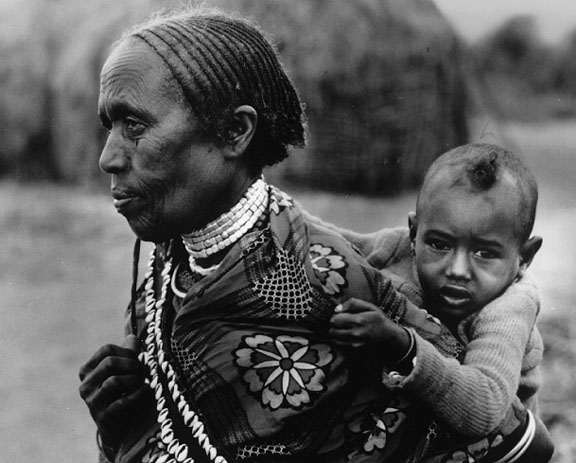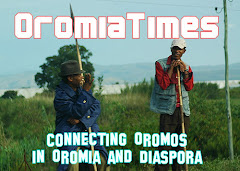Say my Name:
Equal Exchange Mulls Re-naming Ethiopian Coffee
 |
| Joe Riemann, Equal Exchange Coffee Co-op and Arfasse Gemeda, Youth Organizer for the Oromo Community of Minnesota |
Is Organic Ethiopian coffee misnamed? Equal Exchange thinks so, and out of respect for the largest ethnic group in Ethiopia, Equal Exchange Coffee Co-op is changing the name of its Organic Ethiopian coffee to Organic Oromian.
Fair Trade Organic Ethiopian Coffee is Equal Exchange's second best selling "Point of Origin" coffee (Colombian is first) and the coffee company purchased over 420,000 lbs of coffee from Ethiopia last year, for use in various blends.
Equal Exchange will test-launch this name change in Minnesota co-ops in February.
"Some customers may see it as just a new name for their coffee," said Equal Exchange's Joe Riemann, responsible for spearheading this project, "but coffee means so much to the Oromian people. This name change is powerful for them on a real personal, social, and cultural identity level."
 |
| Starting in February, co-op shoppers will see signs like this one on Equal Exchange's Organic Ethiopian |
The name change from Ethiopian to "Organic Oromian" would specify for consumers where the coffee comes from, Oromia (o-ROH-mia), which is the homeland of the Oromo people.
"Oromia isn't internationally recognized," Riemann said, "and that's the problem."
Oromos constitute the largest ethnic group in Ethiopia, and nearly one hundred percent of Equal Exchange's Fair Trade Organic Ethiopian coffee comes from the Oromia Coffee Cooperative Union. In fact, much of the coffee grown in Ethiopia is grown in Oromia.
The name change is being tested here because Minnesotans have a unique connection to Oromia: We are home to the largest single Oromo population outside Ethiopia. Some 20,000 Oromos live in Minnesota, according to Oromo Community in Minnesota.
"This community is right under our noses, and most shop in the same places where co-op people shop, go to the same coffee shops. It felt important to reach out to them and co-op shoppers at the same time," Riemann said.
"Bringing Oromos and co-op shoppers together over Fair Trade coffee is a very cool thing."
Say My Name
As Riemann said, it might seem a matter of semantics, but Oromos have endured stiff cultural repression for decades under various Ethiopian administrations. As explained by spokesperson from the Oromo Community of Minnesota, who asked to remain anonymous for this article, cultural identity is always at stake for Oromos.
"Nearly 100% of Ethiopian coffee comes from Oromia. But the government of Ethiopia wants to hide Oromia by not attaching [its] real name to the coffee. There are strong identity issues at play in this issue."
This is because Oromos have been subject to what can only be called "ethnic cleansing" in Ethiopia. Under several governments dating back to Emperor Selassie (who was overthrown in 1974) the Oromo language was banned, their people were resettled, unlawful internments were forced upon them, and even the name "Oromia" was replaced by a highly offensive moniker. For this reason, identifying Oromian coffee as "Ethiopian" is one more way of keeping these people invisible.
"I deserve to be called by my right name," said the spokesperson. "If someone calls me by a name I don't want, that's an infringement of one's rights. We greatly appreciate Equal Exchange for being a voice to Oromos in Oromia."
Black Gold
The need for a name change became clear after a recent showing of the movie Black Gold, a documentary about Fair Trade coffee featuring the Oromia Coffee Farmers Cooperative Union in Ethiopia. The movie was shown jointly by Equal Exchange and the Oromo Student Union, and the discussion afterwards was potent. The audience was almost all Oromos except for Riemann and Scott Patterson, coordinator of Equal Exchange's Minneapolis Office.
"Afterwards, they were asking, 'Why is this coffee called Ethiopian when it comes from Oromia?' " Riemann said. "It was totally emotional. I mean, I got emotional, too."
Dee, an Oromo American woman, was deeply moved by Black Gold, especially by images of starving children in lush green farmland.
"There was a lot of concern and emotion in the room that night. The people on my mother's side were all coffee farmers," Dee said. Dee herself is part of a generation born in diaspora here in Minnesota, people who fled cultural oppression in Ethiopia. "My generation, we're aware that coffee is part of our culture, but we don't make connections about where we're buying our coffee here."
She added, "I've only been drinking Equal Exchange coffee since that night."
Aware that Equal Exchange might act on behalf of Oromos in America as well as Ethiopia, Riemann wanted his company to consider a name change for the coffee, to honor the people who grow this coffee.
But can a company give up name recognition and "brand" allegiance so easily? "Ethiopian" is one of the most widely recognized coffee names on the market, after all.
So to weigh support for the name change, Equal Exchange posted a "friendly petition" online, and Oromos from around the planet have weighed in to voice their approval. From the petition site:
By changing the name of your "Organic Ethiopian" to "Organic Oromian", you will give an opportunity for the voices of the millions of oppressed Oromo people to be heard.
Recognition of the Oromo people will eventually improve the human rights situation in Ethiopia and improve stability in the Horn of Africa.
We families of coffee growers want our coffee should be named "Oromian organic coffee" and not Ethiopian organic coffee.
Over a thousand signatures have been gathered so far from Oromos and others in far-flung regions, from Australia, Canada, Kentucky, to Germany.
"This is their family," said Scott Patterson, coordinator of Equal Exchange's Minneapolis office, "but it's Fair trade, too. It's two white guys in a room of black folks, talking about social justice in Ethiopia. This is really what Fair Trade is all about."
Just the Beginning
Because Oromos live in the West Bank, St. Paul, and Mankato, Equal Exchange believes that Minnesotans are in a better position to understand the need for this name change than others. But it's Equal Exchange's hope that the co-op community here, in particular, will embrace this change and raise the profile of Oromos in America.
"Fair trade isn't a happy touchy feely story," Patterson said, referring to the hurt and injustice behind the need for this name change. "There are no illusions. It isn't fixed. Oromos know the reality, and it's important for us to face that with them. The story is just starting."
 Black Gold (trailer) (YouTube)
Black Gold (trailer) (YouTube)
 "Freedom is Key", by Oromo rapper Epidemicthevirus (YouTube)
"Freedom is Key", by Oromo rapper Epidemicthevirus (YouTube)

 A young man proudly stands behind the Oromo flag in a small room where Jamal Abdu Wadai often spends hours discussing the social affairs regarding Yemen’s Oromo community. Wadai claims to be the leader of the Oromo community in Sana’a.
A young man proudly stands behind the Oromo flag in a small room where Jamal Abdu Wadai often spends hours discussing the social affairs regarding Yemen’s Oromo community. Wadai claims to be the leader of the Oromo community in Sana’a.

























